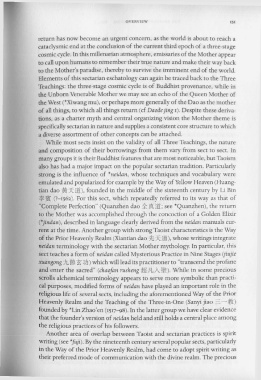Page 191 - The Encyclopedia of Taoism v1_A-L
P. 191
OVERVIEW 151
return has now become an urgent concern, as the world is about to reach a
cataclysmic end at the conclusion of the current third epoch of a three-stage
cosmic cycle. In this millenarian atmosphere, emissaries of the Mother appear
to call upon humans to remember their true nature and make their way back
to the Mother's paradise, thereby to survive the imminent end of the world.
Elements of this sectarian eschatology can again be traced back to the Three
Teachings: the three-stage cosmic cycle is of Buddhist provenance, while in
the Unborn Venerable Mother we may see an echo of the Queen Mother of
the West (*Xiwang mu), or perhaps more generally of the Dao as the mother
of all things, to which all things return (cf Daode jing I). Despite these deriva-
tions, as a charter myth and central organizing vision the Mother theme is
specifically sectarian in nature and supplies a consistent core structure to which
a diverse assortment of other concepts can be attached.
While most sects insist on the validity of all Three Teachings, the nature
and composition of their borrowings from them vary from sect to sect. In
many groups it is their Buddhist features that are most noticeable, but Taoism
also has had a major impact on the popular sectarian tradition. Particularly
strong is the influence of *neidan, whose techniques and vocabulary were
emulated and popularized for example by the Way of Yellow Heaven (Huang-
tian dao ~7(J!!) , founded in the middle of the sixteenth century by Li Bin
* ~ (?-I562). For this sect, which repeatedly referred to its way as that of
"Complete Perfection" (Quanzhen dao ~~J!!; see *Quanzhen), the return
to the Mother was accomplished through the concoction of a Golden Elixir
(*jindan), described in language clearly derived from the neidan manuals cur-
rent at the time. Another group with strong Taoist characteristics is the Way
of the Prior Heavenly Realm (Xiantian dao :JiG7(J!!), whose writings integrate
neidan terminology with the sectarian Mother mythology. In particular, this
ect teaches a form of neidan called Mysterious Practice in Nine Stages (jiujie
xuangong JL f.!1'i ~ J}J) which will lead its practitioner to "transcend the profane
and enter the sacred" (chaofan rusheng JmfLA~n While in some precious
scrolls alchemical terminology appears to serve more symbolic than practi-
cal purposes, modified forms of neidan have played an important role in the
religious life of several sects, including the aforementioned Way of the Prior
Heavenly Realm and the Teaching of the Three-in-One (Sanyi jiao .=: - ~)
founded by *Lin Zhao' en (I5I7-98). In the latter group we have clear evidence
that the founder's version of neidan held and still holds a central place among
the religious practices of his followers.
Another area of overlap between Taoist and sectarian practices is spirit
writing (see *foji). By the nineteenth century several popular sects, particularly
in the Way of the Prior Heavenly Realm, had come to adopt spirit writing as
their preferred mode of communication with the divine realm. The precious

